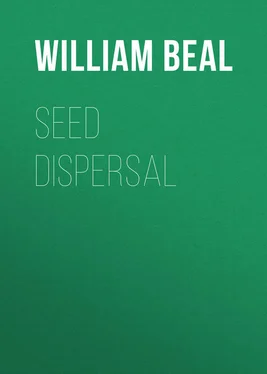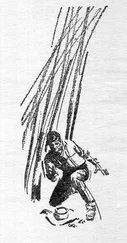William Beal - Seed Dispersal
Здесь есть возможность читать онлайн «William Beal - Seed Dispersal» — ознакомительный отрывок электронной книги совершенно бесплатно, а после прочтения отрывка купить полную версию. В некоторых случаях можно слушать аудио, скачать через торрент в формате fb2 и присутствует краткое содержание. Жанр: foreign_antique, foreign_prose, на английском языке. Описание произведения, (предисловие) а так же отзывы посетителей доступны на портале библиотеки ЛибКат.
- Название:Seed Dispersal
- Автор:
- Жанр:
- Год:неизвестен
- ISBN:нет данных
- Рейтинг книги:5 / 5. Голосов: 1
-
Избранное:Добавить в избранное
- Отзывы:
-
Ваша оценка:
- 100
- 1
- 2
- 3
- 4
- 5
Seed Dispersal: краткое содержание, описание и аннотация
Предлагаем к чтению аннотацию, описание, краткое содержание или предисловие (зависит от того, что написал сам автор книги «Seed Dispersal»). Если вы не нашли необходимую информацию о книге — напишите в комментариях, мы постараемся отыскать её.
Seed Dispersal — читать онлайн ознакомительный отрывок
Ниже представлен текст книги, разбитый по страницам. Система сохранения места последней прочитанной страницы, позволяет с удобством читать онлайн бесплатно книгу «Seed Dispersal», без необходимости каждый раз заново искать на чём Вы остановились. Поставьте закладку, и сможете в любой момент перейти на страницу, на которой закончили чтение.
Интервал:
Закладка:
William J. Beal
Seed Dispersal
This little book is prepared with the thought of helping young botanists and teachers. Unless the reader has followed in detail, by actual experience, some of the modes of plant dispersion, he can have little idea of the fascination it affords, or the rich rewards in store for patient investigation.
A brief list of contributions to the subject is given; but, with very few exceptions, the statements here made, unless otherwise mentioned in the text, are the results of observations by the author.
I am under obligations for suggestions by my colleague, Prof. W. B. Barrows; my assistant, Prof. C. F. Wheeler; and a former instructor of botany, L. H. Dewey, now of the United States Department of Agriculture. B. O. Longyear, instructor in botany, with very few exceptions, has made the drawings.
W. J. BEAL.AGRICULTURAL COLLEGE, MICHIGAN.
CHAPTER I
HOW ANIMALS GET ABOUT
1. Most of the larger animals move about freely. —When danger threatens, the rabbit bounds away in long jumps, seeking protection in a hollow tree, a log, or a hole in the ground. When food becomes scarce, squirrels quickly shift to new regions. Coons, bears, skunks, and porcupines move from one neighborhood to another. When the thickets disappear and hunters abound, wild turkeys and partridges retreat on foot or by wing. When the leaves fall and the cold winds blow, wild geese leave the lakes in secluded northern homes, and with their families, reared during the summer, go south to spend the winter. Turtles swim from pond to pond or crawl from the water to the sand bank, where they lay and cover their eggs. Fishes swim up or down the creek with changing seasons, or seek deep or shallow water as their needs require. Beetles and butterflies, when young, crawl about for food and shelter, and when older use their wings in going long distances.
These examples only serve to recall to mind what every boy or girl knows and has known ever since he can remember – that most animals move about whenever they want to, or whenever other animals will let them.
2. Some animals catch rides in one way or another. —Some small animals, like lice, ticks, and tiny spiders, walk slowly and only for short distances. If, because of scarcity of food, they are suddenly seized with the desire to move for a long distance, what are they to do? On such occasions ticks and lice watch quietly the first opportunity, catch on to the feet of birds or flying insects or other animals which may happen to come their way, and, like a boy catching on to a farmer's sleigh, ride till they get far enough, then jump off or let go, to explore the surrounding country and see whether it is fit to live in. If for some reason a spider grows dissatisfied and wants to leave the home spot, she climbs to the top of some object and spins out a fine, long web; this floats in the air, and after a while becomes so long and light that the wind will bear the thread and the spinner for a considerable distance, no one knows how far. These facts about lice and spiders show how wingless insects can go long distances without wings of their own.
How is it with plants? The woods, fields, marshes, roadsides ever abound with interesting objects provided with strange devices waiting to be studied by inquisitive girls and boys in and out of school, and this finding out of nature's puzzles is one of the deepest pleasures of life.
How quickly a mould attacks and creeps or spreads through a basin of berries every one knows. The mould is as much a plant as the bush that produced the berries; it comes from a small spore, which takes the place of a bud or sprout or seed. The decay of a tree begins where a limb or root has been injured, and whether the timber is living or dead, this decay results from the growth of some one or more low forms of plant life which enter the timber in certain places and slowly or quickly penetrate and affect other portions more or less remote.
CHAPTER II
PLANTS SPREAD BY MEANS OF ROOTS
3. Fairy rings. —Several low forms of plant life, such as Marasmius oreades , Spathularia flavida , and some of the puffballs, start in isolated spots in the grass of a lawn or pasture, and spread each year from a few inches to a foot or more in every direction, usually in the form of a circle; at the end of fifteen years some of these circles acquire a diameter of fifteen to twenty feet or more. These are known as fairy rings. Before science dispelled the illusion they were believed to have been the work of witches, elves, or evil spirits, from which arose the name.
Several kinds of lichens and mosses and the like, growing on the barks of trees, fence boards, and low ground, spread slowly in the manner of fairy rings.
However, the spreading is not always a slow, creeping process, for sometimes these low plants spread over an incredible distance in a short space of time. In some instances they appear suddenly almost anywhere, and at any season of the year. They are all minute and exist in countless numbers, and their devices for securing wide dispersion are so various as to entitle them to first rank in this respect. Some send off spores with a sharp puff, as if shot from a little gun. Some of these spores float on water, and some are sticky and thus gain free rides. It is not at all improbable that some are carried by the winds across oceans and continents.
It is well known that many of the lower species of plants are more widely distributed over the earth than most of the higher plants. Every cloud from a ripe puffball consists of thousands of spores started on the wings of the wind for an unknown journey. Their habits are not past finding out, but to examine them a person needs a good microscope. Most of them have no special common name, and with one or two exceptions further mention of the mode of distribution of this fascinating portion of plant life cannot here be made.
In our botanic garden was planted a patch six feet across of what is known as Oswego tea, bee balm, or red-flowered bergamot, an interesting plant with considerable beauty. It grew well for a year, the next year it failed to some extent, and on the third most of the plants died, or nearly died, excepting the spreading portion all around the margin. This is a fairy ring of another type, and represents a very slow mode of travel. As further illustrations of this topic study common yarrow, betony, several mints, common iris, loosestrife, coreopsis, gill-over-the-ground, several wild sunflowers, horehound, and many other perennials that have grown for a long time without transplanting.
The roots of plants are seldom much observed, because they are out of sight. In soft ground the roots of the common or black locust extend from twenty to forty feet in each direction, and almost anywhere along these roots buds may appear, and a shoot spring up and become a tree.
This peculiarity is worth as much to locusts in the matter of spreading as though the parent trees were able to move about. A number of kinds of poplars and willows, ailanthus, some of the elms, ashes, sweet potatoes, milkweeds, Canada thistles, and others behave in a similar manner. Little bits of Canada-thistle root half an inch long may send forth buds, and each bud grow to be an independent plant.
Roots have a peculiarity not usually known. They stretch out and crook about here and there, penetrating the crevices of the soil wherever there is the least chance, and the matured portions begin to shorten, reminding one somewhat of an angleworm when one end has been stepped on. By this shortening process the top or crown of a dandelion or plantain is pulled down beneath the surface of the ground.
Читать дальшеИнтервал:
Закладка:
Похожие книги на «Seed Dispersal»
Представляем Вашему вниманию похожие книги на «Seed Dispersal» списком для выбора. Мы отобрали схожую по названию и смыслу литературу в надежде предоставить читателям больше вариантов отыскать новые, интересные, ещё непрочитанные произведения.
Обсуждение, отзывы о книге «Seed Dispersal» и просто собственные мнения читателей. Оставьте ваши комментарии, напишите, что Вы думаете о произведении, его смысле или главных героях. Укажите что конкретно понравилось, а что нет, и почему Вы так считаете.












